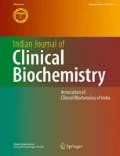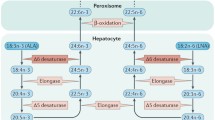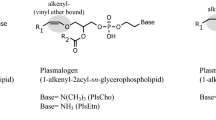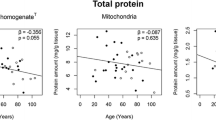Abstract
Docosahexaenoic (DHA) and arachidonic acids (AA) are polyunsaturated fatty acids (PUFAs), major components of brain tissue and neural systems, and the precursors of a number of biologically active metabolites with functions in inflammation resolution, neuroprotection and other actions. As PUFAs are highly susceptible to peroxidation, we hypothesised whether cigarette smokers would present altered PUFAs levels in plasma and erythrocyte phospholipids. Adult males from Indian, Sri-Lankan or Bangladeshi genetic backgrounds who reported smoking between 20 and 60 cigarettes per week were recruited. The control group consisted of matched non-smokers. A blood sample was taken, plasma and erythrocyte total lipids were extracted, phospholipids were separated by thin layer chromatography, and the fatty acid content analysed by gas chromatography. In smokers, dihomo-gamma-linolenic acid, the AA precursor, was significantly reduced in plasma and erythrocyte phosphatidylcholine. AA and DHA were significantly reduced in erythrocyte sphingomyelin. Relatively short term smoking has affected the fatty acid composition of plasma and erythrocyte phospholipids with functions in neural tissue composition, cell signalling, cell growth, intracellular trafficking, neuroprotection and inflammation, in a relatively young population. As lipid peroxidation is pivotal in the pathogenesis of atherosclerosis and neurodegenerative diseases such as Alzheimer disease, early effects of smoking may be relevant for the development of such conditions.
Similar content being viewed by others
References
Erhardt L. Cigarette smoking: an undertreated risk factor for cardiovascular disease. Atherosclerosis. 2009;205(1):23–32.
Freikman I, Amer J, Cohen JS, Ringel I, Fibach E. Oxidative stress causes membrane phospholipid rearrangement and shedding from RBC membranes—an NMR study. Biochim Biophys Acta. 2008;1778(10):2388–94.
Fisher SD, Zareba W, Moss AJ, Marder VJ, Sparks CE, Hochman J, et al. Effect of smoking on lipid and thrombogenic factors 2 months after acute myocardial infarction. Am J Cardiol. 2000;86(8):813–8.
Kajikawa S, Harada T, Kawashima A, Imada K, Mizuguchi K. Highly purified eicosapentaenoic acid prevents the progression of hepatic steatosis by repressing monounsaturated fatty acid synthesis in high-fat/high-sucrose diet-fed mice. Prostaglandins Leukot Essent Fatty Acids. 2009;80(4):229–38.
Doll R, Peto R, Wheatley K, Gray R, Sutherland I. Mortality in relation to smoking: 40 years’ observations on male British doctors. BMJ. 1994;309(6959):901–11.
Crawford MA, Hassam AG, Williams G. Essential fatty acids and fetal brain growth. Lancet. 1976;7957:452–3.
Sinclair AJ, Crawford MA. Low-fat diets and the survival of newborn rats. Biochem J. 1972;126(3):18P–9P.
Anderson GJ, Connor WE, Corliss JD. Docosahexaenoic acid is the preferred dietary n-3 fatty acid for the development of the brain and retina. Pediatr Res. 1990;27(1):89–97.
McCann JC, Ames BN. Is docosahexaenoic acid, an n-3 long-chain polyunsaturated fatty acid, required for development of normal brain function? An overview of evidence from cognitive and behavioral tests in humans and animals. Am J Clin Nutr. 2005;82(2):281–95.
Neuringer M. Infant vision and retinal function in studies of dietary long-chain polyunsaturated fatty acids: methods, results, and implications. Am J Clin Nutr. 2000;71(1 Suppl):256S–67S.
Cao D, Kevala K, Kim J, Moon HS, Jun SB, Lovinger D, Kim HY. Docosahexaenoic acid promotes hippocampal neuronal development and synaptic function. J Neurochem. 2009;111(2):510–21.
Kitajka K, Sinclair AJ, Weisinger RS, Weisinger HS, Mathai M, Jayasooriya AP, et al. Effects of dietary omega-3 polyunsaturated fatty acids on brain gene expression. Proc Natl Acad Sci USA. 2004;101(30):10931–6.
Yavin E, Brand A, Green P. Docosahexaenoic acid abundance in the brain: a biodevice to combat oxidative stress. Nutr Neurosci. 2002;5(3):149–57.
Niemoller TD, Bazan NG. Docosahexaenoic acid neurolipidomics. Prostaglandins Other Lipid Mediat. 2010;91(3–4):85–9.
Berman DR, Liu YQ, Barks J, Mozurkewich E. Docosahexaenoic acid confers neuroprotection in a rat model of perinatal hypoxia-ischemia potentiated by Escherichia coli lipopolysaccharide-induced systemic inflammation. Am J Obstet Gynecol. 2010;202(5):469.e1–6.
Arnold C, Markovic M, Blossey K, Wallukat G, Fischer R, Dechend R, et al. Arachidonic acid-metabolizing cytochrome P450 enzymes are targets of {omega}-3 fatty acids. J Biol Chem. 2010;285(43):32720–33.
Nithipatikom K, DiCamelli RF, Kohler S, Gumina RJ, Falck JR, Campbell WB, Gross GJ. Determination of cytochrome P450 metabolites of arachidonic acid in coronary venous plasma during ischemia and reperfusion in dogs. Anal Biochem. 2001;292(1):115–24.
Serhan CN. Lipoxins and aspirin-triggered 15-epi-lipoxins are the first lipid mediators of endogenous anti-inflammation and resolution. Prostaglandins Leukot Essent Fatty Acids. 2005;73(3–4):141–62.
Spiteller G. Linoleic acid peroxidation–the dominant lipid peroxidation process in low density lipoprotein–and its relationship to chronic diseases. Chem Phys Lipids. 1998;95(2):105–62.
Leng GC, Smith FB, Fowkes FG, Horrobin DF, Ells K, Morse-Fisher N, Lowe GD. Relationship between plasma essential fatty acids and smoking, serum lipids, blood pressure and haemostatic and rheological factors. Prostaglandins Leukot Essent Fatty Acids. 1994;51(2):101–8.
Thorsdottir I, Hill J, Ramel A. Omega-3 fatty acid supply from milk associates with lower type 2 diabetes in men and coronary heart disease in women. Prev Med. 2004;39(3):630–4.
Wood LG, Scott HA, Garg ML, Gibson PG. Innate immune mechanisms linking non-esterified fatty acids and respiratory disease. Prog Lipid Res. 2009;48(1):27–43.
Kemperman RF, Veurink M, van der Wal T, Knegtering H, Bruggeman R, Fokkema MR, et al. Low essential fatty acid and B-vitamin status in a subgroup of patients with schizophrenia and its response to dietary supplementation. Prostaglandins Leukot Essent Fatty Acids. 2006;74(2):75–85.
Liu Q, Smith MA, Avilá J, DeBernardis J, Kansal M, Takeda A, et al. Alzheimer-specific epitopes of tau represent lipid peroxidation-induced conformations. Free Radic Biol Med. 2005;38(6):746–54.
Santos MT, Valles J, Aznar J, Beltrán M, Herraiz M. Effect of smoking on plasma and platelet fatty acid composition in middle-aged men. Atherosclerosis. 1984;50(1):53–62.
Hibbeln JR, Makino KK, Martin CE, Dickerson F, Boronow J, Fenton WS. Smoking, gender, and dietary influences on erythrocyte essential fatty acid composition among patients with schizophrenia or schizoaffective disorder. Biol Psychiatry. 2003;53(5):431–41.
Mancini NM, Béné MC, Gérard H, Chabot F, Faure G, Polu JM, Lesur O. Early effects of short-time cigarette smoking on the human lung: a study of bronchoalveolar lavage fluids. Lung. 1993;171(5):277–91.
Cataldo JK, Prochaska JJ, Glantz SA. Cigarette smoking is a risk factor for Alzheimer’s disease: an analysis controlling for tobacco industry affiliation. J Alzheimers Dis. 2010;19(2):465–80.
Harwood DG, Kalechstein A, Barker WW, Strauman S, St George-Hyslop P, Iglesias C, et al. The effect of alcohol and tobacco consumption, and apolipoprotein E genotype, on the age of onset in Alzheimer’s disease. Int J Geriatr Psychiatry. 2010;25(5):511–8.
McKeigue PM, Miller GJ, Marmot MG. Coronary heart disease in south Asians overseas: a review. J Clin Epidemiol. 1989;42(7):597–609.
Wild S, McKeigue P. Cross sectional analysis of mortality by country of birth in England and Wales, 1970–92. BMJ. 1997;314(7082):705–10.
Folch J, Lees M, Sloane Stanley GH. A simple method for the isolation and purification of total lipids from animal tissues. J Biol Chem. 1957;226(1):497–509.
Bueno AA, Ghebremeskel K, Bakheit KH, Elbashir MI, Adam I. Dimethyl acetals, an indirect marker of the endogenous antioxidant plasmalogen level, are reduced in blood lipids of Sudanese pre-eclamptic subjects whose background diet is high in carbohydrate. J Obstet Gynaecol. 2012;32(3):241–6.
The Information Centre for Health and Social Care, National Health Service. Statistics on smoking: England. ISBN 978-1-84636-327-6, 2009 http://www.ic.nhs.uk/webfiles/publications/smoking09/Statistics_on_smoking_England_2009.pdf. Accessed 26 July 2012.
Office for National Statistics. National Population Projections, 2010-based projections. http://www.ons.gov.uk/ons/rel/npp/national-population-projections/2010-based-projections/index.html Posted 26 Oct 2011; Accessed 26 July 2012.
Isobe Y, Arita M, Matsueda S, Iwamoto R, Fujihara T, Nakanishi H, et al. Identification and structure determination of novel anti-inflammatory mediator resolvin E3, 17,18-dihydroxyeicosapentaenoic acid. J Biol Chem. 2012;287(13):10525–34.
Yamaji-Hasegawa A, Tsujimoto M. Asymmetric distribution of phospholipids in biomembranes. Biol Pharm Bull. 2006;29(8):1547–53.
Liscovitch M, Ben-Av P, Danin M, Faiman G, Eldar H, Livneh E. Phospholipase D-mediated hydrolysis of phosphatidylcholine: role in cell signalling. J Lipid Mediat. 1993;8(3):177–82.
Heipertz R, Pilz H, Seidel D, Klauke W, Goebel HH. Fatty acid composition of myelin lipids (cerebrosides, sulphatides and sphingomyelin) from normal human sural nerve, and changes in peripheral neuropathy. Neuropathol Appl Neurobiol. 1978;4(3):197–207.
Hannun YA, Obeid LM. Ceramide: an intracellular signal for apoptosis. Trends Biochem Sci. 1995;20(2):73–7.
Girotti AW. Mechanisms of lipid peroxidation. J Free Radic Biol Med. 1985;1(2):87–95.
Catalá A. Lipid peroxidation of membrane phospholipids generates hydroxy-alkenals and oxidized phospholipids active in physiological and/or pathological conditions. Chem Phys Lipids. 2009;157(1):1–11.
Church DF, Pryor WA. Free-radical chemistry of cigarette smoke and its toxicological implications. Environ Health Perspect. 1985;64:111–26.
Pryor WA, Stone K. Oxidants in cigarette smoke. Radicals, hydrogen peroxide, peroxynitrate, and peroxynitrite. Ann N Y Acad Sci. 1993;686:12–27 discussion 27-8.
Rahman I, MacNee W. Role of oxidants/antioxidants in smoking-induced lung diseases. Free Radic Biol Med. 1996;21(5):669–81.
Frei B, Forte TM, Ames BN, Cross CE. Gas phase oxidants of cigarette smoke induce lipid peroxidation and changes in lipoprotein properties in human blood plasma. Protective effects of ascorbic acid. Biochem J. 1991;277(Pt 1):133–8.
Reznick AZ, Cross CE, Hu ML, Suzuki YJ, Khwaja S, Safadi A, et al. Modification of plasma proteins by cigarette smoke as measured by protein carbonyl formation. Biochem J. 1992;286(Pt 2):607–11.
Grune T, Krämer K, Hoppe PP, Siems W. Enrichment of eggs with n-3 polyunsaturated fatty acids: effects of vitamin E supplementation. Lipids. 2001;36(8):833–8.
Reed TT. Lipid peroxidation and neurodegenerative disease. Free Radic Biol Med. 2011;51(7):1302–19.
Smith KJ, Kapoor R, Felts PA. Demyelination: the role of reactive oxygen and nitrogen species. Brain Pathol. 1999;9(1):69–92.
Takai S, Jin D, Kawashima H, Kimura M, Shiraishi-Tateishi A, Tanaka T, et al. Anti-atherosclerotic effects of dihomo-gamma-linolenic acid in ApoE-deficient mice. J Atheroscler Thromb. 2009;16(4):480–9.
Dooper MM, van Riel B, Graus YM, M’Rabet L. Dihomo-gamma-linolenic acid inhibits tumour necrosis factor-alpha production by human leucocytes independently of cyclooxygenase activity. Immunology. 2003;110(3):348–57.
Costall B, Kelly ME, Naylor RJ. The antidyskinetic action of dihomo-gamma-linolenic acid in the rodent. Br J Pharmacol. 1984;83(3):733–40.
Chiu CY, Gomolka B, Dierkes C, Huang NR, Schroeder M, Purschke M, et al. Omega-6 docosapentaenoic acid-derived resolvins and 17-hydroxydocosahexaenoic acid modulate macrophage function and alleviate experimental colitis. Inflamm Res. 2012;61(9):967–76.
Crawford MA, Golfetto I, Ghebremeskel K, Min Y, Moodley T, Poston L, et al. The potential role for arachidonic and docosahexaenoic acids in protection against some central nervous system injuries in preterm infants. Lipids. 2003;38(4):303–15.
Serhan CN, Hamberg M, Samuelsson B. Lipoxins: novel series of biologically active compounds formed from arachidonic acid in human leukocytes. Proc Natl Acad Sci USA. 1984;81(17):5335–9.
Mukherjee PK, Marcheselli VL, Serhan CN, Bazan NG. Neuroprotectin D1: a docosahexaenoic acid-derived docosatriene protects human retinal pigment epithelial cells from oxidative stress. Proc Natl Acad Sci USA. 2004;101(22):8491–6.
Acknowledgments
Prof. K. Ghebremeskel obtained the ethical approval. The authors are grateful to Mr. O. Erkerk, Mr. A. Bhullar, Ms. S. Eram and Dr. Y. Wang for expert technical assistance; to Dr. A. Searle and Prof. M. Crawford for guidance and support. The authors are grateful to the volunteers who participated in this study. This research was conducted at the Faculty of Life Sciences, London Metropolitan University, which funded part of this research. AAB received remuneration from the Mother and Child Foundation, to whom we are also grateful for the use of the equipment and some consumables purchased by the Foundation.
Conflict of Interests
The authors have no conflict of interest to declare.
Author information
Authors and Affiliations
Corresponding author
Rights and permissions
About this article
Cite this article
Ionescu, N., de Freitas, C. & Bueno, A.A. Perturbations in Blood Phosphatidylcholine and Sphingomyelin Fatty Acid Composition in a Sample Population of Cigarette Smokers. Ind J Clin Biochem 28, 361–367 (2013). https://doi.org/10.1007/s12291-013-0327-y
Received:
Accepted:
Published:
Issue Date:
DOI: https://doi.org/10.1007/s12291-013-0327-y




